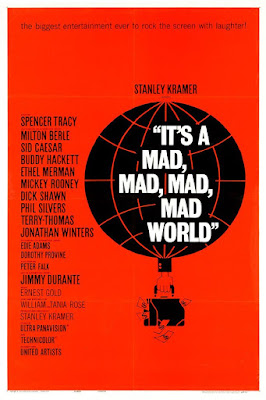A conga line of adjectives sometimes (but not always) requires the intervention of commas to keep things straight.
 |
| Myfanwy’s dragon, Trevor, has multiple red heads. |
In formal writing,
coordinate adjectives—two or more adjectives that describe the same noun—should be separated by a comma. (Some people get a little carried away and put a comma before the noun too. These people are wrong. They deserve pity but not indulgence.)
- The demon made a dedicated, insinuating telemarketer.
- My ex is a low-down, no-good, lying rattlesnake.
However, sometimes two or more adjectives get by just fine with no commas at all.
- The only one who can safely walk the halls of the cursed high school is Sven, the janitor-ninja.
- Myfanwy’s dragon, Trevor, has multiple red heads.
How can you tell when your adjectives need a comma and when they don’t? Here are two helpful rules of thumb.
The Magic And
If you can put
and between your adjectives, you should separate them with a comma. If
and doesn’t sound right, no comma is needed.
- The demon made a dedicated and insinuating telemarketer. (✓ use comma)
- The only one who can safely walk the halls of the cursed and high school is Sven, the janitor-ninja. (X no comma)
The Adjective Switcheroo
Another approach is to swap your adjectives around. If your sentence still makes sense, use a comma. If not, leave it out.
- My ex is a lying, low-down, no-good rattlesnake. (✓ use commas)
- Myfanwy’s dragon, Trevor, has red multiple heads. (X no comma)
 |
| The only one who can safely walk the halls of the cursed high school is Sven, the janitor-ninja. |
Why Adjectives Sometimes Don’t Need Commas
When one of the adjectives bonds with its noun to form a single idea, you don’t need to use a comma.
Cursed describes “high school” as a unit, rather than the two adjectives
cursed and
high describing
school. Similarly,
multiple describes not just Trevor’s heads but his red heads.
- Janelle attended prom in a jet-black three-piece suit.
- Agnetha cannonballed into the dark blue depths of the space-time rift.
The colour jet black describes a three-piece suit, not a suit that happens to come in three pieces. In the second sentence,
dark is describing
blue, not
depths. It’s acting as an adverb—describing an adjective—not a coordinate adjective.
- It was a cold winter morning on Venus.
- The Brontë sisters’ consumption worsened in cold, damp weather.
The first example shows us a winter morning that’s cold;
winter is bonded with
morning. The second example shows us weather that is both cold and damp, not damp weather that’s cold.
- That little old lady is a kung fu master.
Common expressions like “little old lady” or “big bad wolf” don’t take commas.
How Much Do We Need These Commas, Really?
These days, writers—especially those working in more informal genres—tend to use as few commas as possible. It’s not unusual in modern novels to see a long string of adjectives with nary a comma in sight. So, say you’re a twenty-first-century Faulkner: when do you
really need a comma between adjectives? When it clarifies your meaning or amplifies your tone.
- The yeti was covered in matted white fur.
- The yeti was covered in white, matted fur.
The first sentence presents us with white fur that is matted, the second with fur that is both matted and white. The first reads more quickly and logically, giving us a whole picture, while the second draws our attention to the whiteness of the fur.
Notice that “matted and white fur” sounds weird, but “white and matted fur” doesn’t. That’s an indication that the second sentence needs a comma (remember, if you can put
and between adjectives, you probably need a comma). Another way to think of it is that “white fur” is a recognizable idea, a kind of unit. “Matted fur” is just fur in an untidy state—a description of fur, not a thing in and of itself.
 |
| The yeti was covered in matted white fur. |
- Imogen had a passionate, lifelong love of Marmite, despite its taste.
- Imogen had a passionate lifelong love of Marmite, despite its taste.
The first sentence implies a love that is both passionate and lifelong. The second implies a lifelong love that is passionate. Though the distinction is a subtle one, a writer might feel a strong preference for one version over the other, and their editor would be hard-pressed to say only one was correct.
- What a long, strange trip it’s been.
- Have you read Douglas Adams’s The Long Dark Tea-Time of the Soul?
In the first example, the Grateful Dead’s trip is both long and strange in equal measure, something emphasized by the comma. Adams could have chosen to write
The Long, Dark Tea-Time of the Soul, but he may not have wanted a comma cluttering up his title. When there’s no possibility of reader confusion, whether or not to use a comma is often left to the author’s discretion.
Repeated Adjectives
There is, however, no authorial leeway when it comes to repeating the same adjective. Always separate these clones with commas.
- “My Love Is Like a Red, Red Rose” is by the Scottish poet Robert Burns.
- The movie It’s a Mad, Mad, Mad, Mad World was released in 1963.
 |
| The movie It’s a Mad, Mad, Mad, Mad World was released in 1963. |
Commas are probably our language’s trickiest punctuation, but they’re worth the effort to master, if only for the sense of personal satisfaction, and the crowds of fawning groupies.





